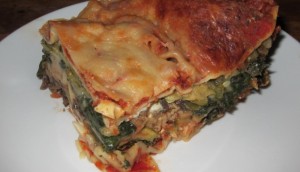Lasagna is the advanced and tastier version of mac & cheese. It’s also a great place to hide heaps of veg if you’re cooking for the meat and potatoes crowd. Layers of sauces, filling, and cheeses keep them distracted from the fact that you don’t really need ground beast in the mix. Now with the advent of ‘instant’ cook lasagna noodles that need no pre-boiling stage, making a stack of Italian goodness couldn’t be easier.
I use wide roasters that measure three inches deep but in reality, I’d like something as deep as five inches to make really impressive looking layers. No matter what height you have, it will taste good thanks to a long slow bake. You need four basic components laid out on your counter in front of a deep dish baking pan for lasagna success. The noodles, a simple tomato sauce, the sauteed vegetables, and the creamy cheesy filling. Let’s tackle them one by one.
For the noodles you really don’t want fresh pasta here. It would disintegrate by the time everything else finished cooking in most cases. Being somewhat of a pasta purist I was skeptical when the ‘no boil’ noodles first hit the market and back then, they were awful. Recent improvements made me revisit those taste tests and now I have to admit they’re almost indistinguishable from ordinary examples as long as you give them plenty of liquid to absorb during baking. And there is perhaps their best selling point. Instead of soaking up pasta water, you can force them to soak up juice from your sauces for a flavour boost all the way to their al dente core.
The tomato sauce is a similarly easy stroll in the pantry. Plain tins of tomatoes, preferably salt-free, can be simmered briefly with a bit of wine, some acid for brightness, and a few select dried herbs. Sauce done. A pass through your blender, processor, or food mill might be called for depending on the cut of your tomatoes but otherwise you need nothing more. The taste will be rounded out perfectly by all the other layers of your creation. Just make sure this sauce is very ‘loose’ and has enough liquid for the noodles to absorb. Crunchy lasagna centres are a terrible thing.
The vegetable filling is where you really get to go wild. Frozen veg works perfectly well if that’s all winter has available to you but you can also draft most any surplus vegetable from your fridge, garden, or discount supermarket rack. Since it will all be diced and simmered, ugly won’t matter. And here is where you can trick those meat eaters with mature mushrooms (their gills have opened with time) that have heaps more taste than younger examples. I use a deep pot and saute everything together using the smallest amount of olive oil in staggered steps for simplicity. Hard veg and mushrooms first followed by softer examples progressively. I’ve used a mix of any or all of the following: mushrooms, carrots, onions, spinach, eggplant, courgettes, kale, chard, chiles, cauliflower, broccoli, corn, garlic, bell pepper, artichoke hearts, and asparagus. Whatever is available and cheap with the more the merrier. Salt and pepper judiciously. A food processor makes quick work of the chopping duty too.
The cheese filling should really be called the ‘creamy’ filling. I think a rookie lasagna mistake is simply using shredded cheese when you have so many more options available that will blend into a better layer. I make a multi-cheese hybrid Mornay sauce by starting a basic Béchamel * (white sauce made with roux and bay-infused milk or cream) then pull all the flavours together over low heat by adding smaller amounts of melting cheese like Gruyere or Mozzarella with some Ricotta for good measure if I’ve got it handy. I always slip in some mustard and nutmeg for an extra bonus too. Some cooks blend in ordinary cottage cheese here but if you choose that route, I’d pulse it in a processor to make it smoother first. Since you can get most any fat content your diet requires, this layer can be as healthy as need be. Watch out for sneaky surplus salt from the cheeses but otherwise season as needed with sea salt and freshly ground peppercorn.
* If you’re in a hurry and don’t mind the calories, you can skip the Béchamel altogether and simply blend a few eggs into pure ricotta with a hefty dash of pepper and nutmeg as an alternative. Just remember that the eggs will expand somewhat so watch for lasagna layer blowout.
After you have your layers ready and reasonably cooled for the best texture, assembly takes mere moments. Tell your kids it’s a new food version of Minecraft and make them do it. A thin layer of tomato sauce lines the bottom then pasta, veg, cheese, and more tomato repeat all the way to the top. A few fine gratings of Parmesan in there somewhere never hurt either. I set the oven to a moderate 175C (350F) and give it a good hour or more but your times will vary depending on the dish used. I also start with a foil cover for the first half of baking so all the liquid stays trapped in the dish to benefit the rapidly softening noodles. Use your probe thermometer to peek into the progress as needed. You can add a final layer of cheese to the top in the last few minutes of baking for the visual effect but really it’s impossible to get a bad dish if you’ve chosen your ingredients well.

These kitchen notes were by request but if you want a full blown recipe, send me a note and I’ll work on it. Really, you can’t make a bad batch of lasagna without trying extra hard to screw it up. Just get more veg in there!

